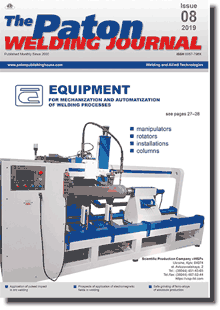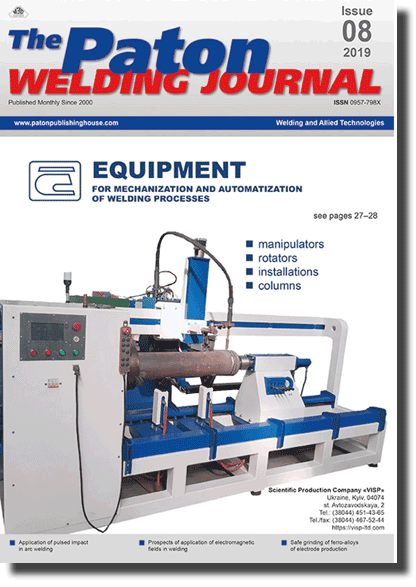| 2019 №08 (05) |
DOI of Article 10.15407/tpwj2019.08.06 |
2019 №08 (07) |

The Paton Welding Journal, 2019, #8, 37-42 pages
Journal The Paton Welding Journal
Publisher International Association «Welding»
ISSN 0957-798X (print)
Issue #8, 2019 (September)
Pages 37-42
Prediction of parameters of friction stir welding process of sheet aluminium alloys
A.G. Poklyatskii
E.O. Paton Electric Welding Institute of the NAS of Ukraine 11 Kazimir Malevich Str., 03150, Kyiv, Ukraine. E-mail: office@paton.kiev.ua
Optimum parameters of the modes of friction stir welding of 0.8–3.0 mm thick aluminium alloys widely used in fabrication of welded structures were determined. It is shown that sound formation of welds can be ensured at tool immersion into the metal being welded to the depth of 0.10–0.15 mm due to correct selection of the frequency of tool rotation and welding speed. A relationship is established between the total content of alloying and modifying elements in the aluminium alloy being welded, welding speed and frequency of tool rotation. A range of optimum relationships was determined, showing the length of the tool linear movement along the butt during one rotation, when sound formation of welds of sheet aluminium alloys AMtsN, AD33, AMg2M, 1460, AMg5M, 1201 and AMg6M is provided. Formulas were derived, which express the dependencies in the form of power functions, limiting this range and allowing calculation of the required speeds of tool rotation and displacement for any aluminium alloy, containing 2.2–8.4 % of alloying and modifying elements. Characteristic defects, forming in welds at deviation of the above parameters from the optimum range, are shown. 18 Ref., 5 Figures.
Keywords: aluminium alloys, friction stir welding, tool rotation speed, welding speed, characteristic defects
Received: 19.05.19
Published: 24.09.19
References
1. Lahti, K. (2003) FSW - possibilities in shipbuilding. Svetsaren, 1, 6-8. https://doi.org/10.22486/iwj.v36i4.1787802. Kuriyama, T. (2008) Advantages of aluminium alloy rolling stocks and transition of carbody structures. J. of Light Metal Welding and Construction, 9, 418-421.
3. Arbegast, W.J. (2006) Friction stir welding after a decade of development. Welding J., 3, 28-35.
4. Ding, J., Carter, R., Lawless, K. et al. (2006) Friction stir welding flies high at NASA. Ibid., 3, 54-59.
5. Okamura, H., Aota, K., Ezumi, M. (2000) Friction Stir welding of aluminium alloy and application to structure. J. of Japan Institute of Light Metals, 4, 166-172. https://doi.org/10.2464/jilm.50.166
6. Defalco, J. (2006) Friction stir welding vs. fusion welding. Welding J., 3, 42-44.
7. Lanciotti, A., Vitali, F. (2003) Characterization of friction welded joints in aluminium alloy 6082-T6 plates. Welding Int., 8, 624-630. https://doi.org/10.1533/weli.17.8.624.21900
8. Kulekci, M.K. (2003) Mechanické vlastnosti spojov hliníkovej zliatiny AlCu4SiMg vyhotovených trecím zvaraním premiešaním. Zvaranie-Svařování, 5-6, 104-107 [in Slovak].
9. Pietras, A., Zadroga, L., Lomozik, M. (2004) Characteristics of welds formed by pressure welding incorporating stirring of the weld material (FSW). Welding Int., 1, 5-10. https://doi.org/10.1533/wint.2004.3215
10. Oosterkamp, A., Oosterkamp, L., Nordeide, A. (2004) «Kissing bond» phenomena in solid-state welds of aluminium alloys. Welding J., 8, 225-231.
11. Poklyatsky, A.G. (2008) Characteristic defects in FSW of sheet aluminium alloys and main causes for their formation. The Paton Welding J., 6, 39-43.
12. Shinoda, T. (2002) Effect of tool angle on metal flow phenomenon in friction stir welds. In: Proc. of 6th Int. Conf. on Trends in Welding Research. Georgia, USA.
13. Okamura, H., Aota, K., Takai, H. et al. (2003) Point of application for FSW. Welding Technology, 5, 60-69.
14. Colegrove, P.A., Shercliff, H.R. (2003) Experimental and numerical analysis of aluminium alloy 7075-T7351 friction stir welds. Sci. and Techn. of Welding and Joining, 5, 360-368. https://doi.org/10.1179/136217103225005534
15. Enomoto, M. (2003) Friction stir welding: research and industrial applications. Welding Int., 5, 341-345. https://doi.org/10.1533/weli.17.5.341.22001
16. Hassan, A.A., Prangnell, P.B., Norman, A.F. et al. (2003) Effect of welding parameters on nugget zone microstructure and properties in high strength aluminium alloy friction stir welds. Ibid., 4, 257-268. https://doi.org/10.1179/136217103225005480
17. Ryazantsev, V.I., Matsnev, V.N., Konkevich, V.Yu. (2004) Friction stir welding of wrought and cast aluminium alloys. Aviats. Promyshlennost, 4, 33-36 [in Russian].
18. Ishchenko, A.Ya., Poklyatsky, A.G. (2010) Tool for friction stir welding of aluminium alloys. Ukraine Pat. 54096. Int. Cl. В23К 20/12, No. u 201005315 [in Ukrainian].
Suggested Citation
A.G. Poklyatskii (2019) Prediction of parameters of friction stir welding process of sheet aluminium alloys. The Paton Welding J., 08, 37-42.The cost of subscription/purchase order journals or individual articles
| Journal/Currency | Annual Set | 1 issue printed |
1 issue |
one article |
| TPWJ/USD | 384 $ | 32 $ | 26 $ | 13 $ |
| TPWJ/EUR | 348 € | 29 € | 24 € | 12 € |
| TPWJ/UAH | 7200 UAH | 600 UAH | 600 UAH | 280 UAH |
| AS/UAH | 1800 UAH | 300 UAH | 300 UAH | 150 UAH |
| AS/USD | 192 $ | 32 $ | 26 $ | 13 $ |
| AS/EUR | 180 € | 30 € | 25 € | 12 € |
| SEM/UAH | 1200 UAH | 300 UAH | 300 UAH | 150 UAH |
| SEM/USD | 128 $ | 32 $ | 26 $ | 13 $ |
| SEM/EUR | 120 € | 30 € | 25 € | 12 € |
| TDNK/UAH | 1200 UAH | 300 UAH | 300 UAH | 150 UAH |
| TDNK/USD | 128 $ | 32 $ | 26 $ | 13 $ |
| TDNK/EUR | 120 € | 30 € | 25 € | 15 € |
AS = «Automatic Welding» - 6 issues per year;
TPWJ = «PATON WELDING JOURNAL» - 12 issues per year;
SEM = «Electrometallurgy Today» - 4 issues per year;
TDNK = «Technical Diagnostics and Non-Destructive Testing» - 4 issues per year.


